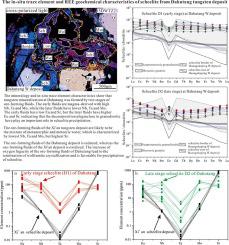当前位置:
X-MOL 学术
›
Ore Geol. Rev.
›
论文详情
Our official English website, www.x-mol.net, welcomes your feedback! (Note: you will need to create a separate account there.)
Origin and evolution of ore-forming fluids in a tungsten mineralization system, Middle Jiangnan orogenic belt, south China: Constraints from in-situ LA–ICP–MS analyses of scheelite
Ore Geology Reviews ( IF 3.3 ) Pub Date : 2020-12-01 , DOI: 10.1016/j.oregeorev.2020.103806 Yong Zhang , Dongsheng Ma , Jian-Feng Gao
Ore Geology Reviews ( IF 3.3 ) Pub Date : 2020-12-01 , DOI: 10.1016/j.oregeorev.2020.103806 Yong Zhang , Dongsheng Ma , Jian-Feng Gao

|
Abstract The Middle Jiangnan orogenic belt is a very important tungsten (W) polymetallic belt in China. There are many types of W deposits in the belt, including veinlet-disseminated and stratabound deposits, which have different origins. The veinlet-disseminated Dahutang W deposit has undergone extensive alteration, such as biotitization (potassic alteration), and greisenization. Scheelite in veinlet-disseminated W mineralization displays a zoned texture indicating at least two generations. The early generation (D1) from the Dahutang W deposit exhibits magmatic hydrothermal characteristics with comparatively high Nb, Ta, and Mo concentrations, but a low Sr concentration (44 to 95 ppm). In contrast, the scheelite samples from the Xi’an W deposit has relatively low Nb, Ta, and Mo concentrations, but a high Sr concentration (582 to 861 ppm), mainly originating from a metamorphic fluid that mixed with meteoric water. The composition of the late generation of scheelite (D2) samples from the Dahutang deposit are intermediate between the composition of scheelite (D1) and scheelite of the Xi’an depsoit. The mineral chemistry of the scheelite samples indicate that the ore-forming fluids of the Dahutang deposit were dominated by magmatic hydrothermal fluids during the early stage, and that meteoric water was added during fluid evolution. The rare earth elements (REEs) in the scheelite samples, especially the variation of the δEu (EuN/((SmN × GdN)0.5)) values, record the change in oxygen fugacity. The ore-forming fluids in the early stage of the Dahutang deposit were reduced becoming oxidized during the precipitation of the D2 scheelite, whereas the ore-forming fluids of the Xi’an deposit were oxidized. An increased oxygen fugacity of the ore-forming fluids of the Dahutang deposit restricted the precipitation of wolframite and promoted the formation of scheelite. Extensive alteration resulted in the decomposition of plagioclase, thus releasing Ca and Sr for the crystallization of scheelite at the Dahutang tungsten deposit.
中文翻译:

华南中江南造山带钨矿化系统成矿流体的成因与演化:对白钨矿原位LA-ICP-MS分析的限制
摘要 江南中造山带是我国非常重要的钨(W)多金属带。带内W型矿床种类繁多,包括细脉播散型和层控型矿床,成因各异。细脉播散型大湖塘W矿床经历了黑云母化(钾化蚀变)、灰化等广泛蚀变。细脉播散的 W 矿化中的白钨矿显示出至少两代的带状结构。大湖塘W矿床早期(D1)具有岩浆热液特征,Nb、Ta、Mo浓度较高,Sr浓度较低(44~95 ppm)。相比之下,西安钨矿的白钨矿样品的 Nb、Ta 和 Mo 浓度相对较低,但 Sr 浓度较高(582 至 861 ppm),主要来源于与大气水混合的变质流体。大湖塘矿床晚代白钨矿(D2)样品的成分介于白钨矿(D1)和西安沉积层白钨矿的成分之间。白钨矿样品的矿物化学表明,大湖塘矿床的成矿流体早期以岩浆热液流体为主,流体演化过程中加入了大气水。白钨矿样品中的稀土元素(REEs),特别是δEu(EuN/((SmN×GdN)0.5))值的变化,记录了氧逸度的变化。大湖塘矿床早期成矿流体在D2白钨矿沉淀过程中被还原氧化,而西安矿床的成矿流体则被氧化。大湖塘矿床成矿流体氧逸度升高,限制了黑钨矿的沉淀,促进了白钨矿的形成。广泛的蚀变导致斜长石分解,从而释放出Ca和Sr,用于大湖塘钨矿床的白钨矿结晶。
更新日期:2020-12-01
中文翻译:

华南中江南造山带钨矿化系统成矿流体的成因与演化:对白钨矿原位LA-ICP-MS分析的限制
摘要 江南中造山带是我国非常重要的钨(W)多金属带。带内W型矿床种类繁多,包括细脉播散型和层控型矿床,成因各异。细脉播散型大湖塘W矿床经历了黑云母化(钾化蚀变)、灰化等广泛蚀变。细脉播散的 W 矿化中的白钨矿显示出至少两代的带状结构。大湖塘W矿床早期(D1)具有岩浆热液特征,Nb、Ta、Mo浓度较高,Sr浓度较低(44~95 ppm)。相比之下,西安钨矿的白钨矿样品的 Nb、Ta 和 Mo 浓度相对较低,但 Sr 浓度较高(582 至 861 ppm),主要来源于与大气水混合的变质流体。大湖塘矿床晚代白钨矿(D2)样品的成分介于白钨矿(D1)和西安沉积层白钨矿的成分之间。白钨矿样品的矿物化学表明,大湖塘矿床的成矿流体早期以岩浆热液流体为主,流体演化过程中加入了大气水。白钨矿样品中的稀土元素(REEs),特别是δEu(EuN/((SmN×GdN)0.5))值的变化,记录了氧逸度的变化。大湖塘矿床早期成矿流体在D2白钨矿沉淀过程中被还原氧化,而西安矿床的成矿流体则被氧化。大湖塘矿床成矿流体氧逸度升高,限制了黑钨矿的沉淀,促进了白钨矿的形成。广泛的蚀变导致斜长石分解,从而释放出Ca和Sr,用于大湖塘钨矿床的白钨矿结晶。



























 京公网安备 11010802027423号
京公网安备 11010802027423号